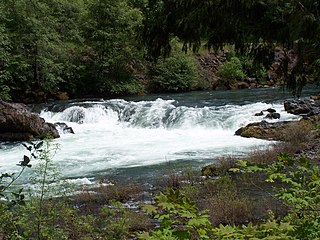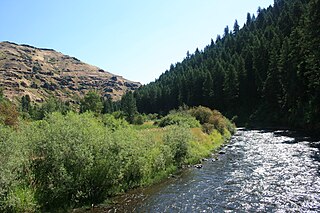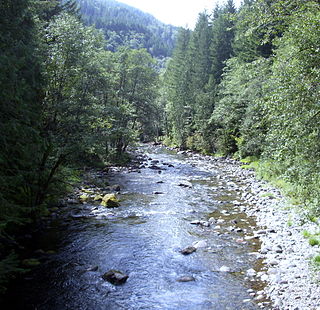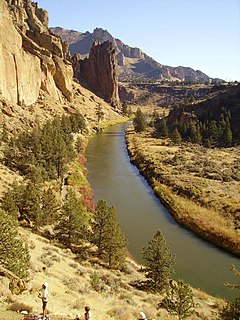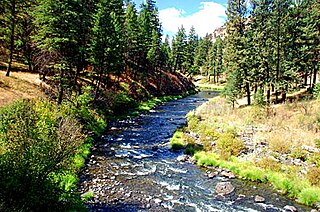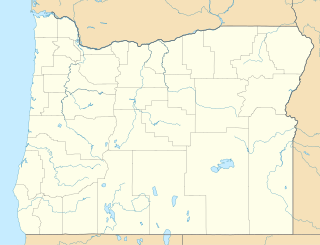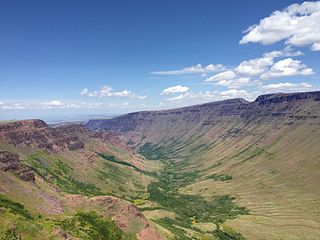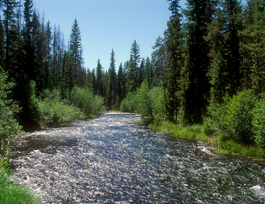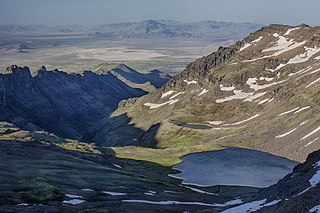| North Powder River | |
| Country | United States |
|---|---|
| State | Oregon |
| County | Union and Baker |
| Source | Blue Mountains |
| - location | Wallowa–Whitman National Forest |
| - elevation | 7,627 ft (2,325 m) [1] |
| - coordinates | 44°52′15″N118°12′14″W / 44.87083°N 118.20389°W [2] |
| Mouth | Powder River |
| - location | North Powder, Oregon |
| - elevation | 3,205 ft (977 m) [2] |
| - coordinates | 45°02′19″N117°53′44″W / 45.03861°N 117.89556°W Coordinates: 45°02′19″N117°53′44″W / 45.03861°N 117.89556°W [2] |
| Length | 25 mi (40 km) [3] |
| Basin | 118 sq mi (306 km2) [3] |
| Discharge | |
| - average | 90 cu ft/s (3 m3/s) [3] |
| Type | Scenic |
| Designated | October 28, 1988 |
The North Powder River is a 25-mile (40 km) tributary of the Powder River in the northeastern part of the U.S. state of Oregon. [3] Fed by water from three small, high-elevation lakes, it begins in the Elkhorn Mountains, a sub-range of the Blue Mountains of the Pacific Northwest. [4] From there it flows generally east to meet the larger river near the city of North Powder. [5]
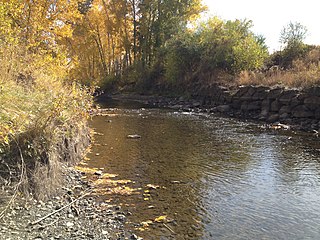
The Powder River is a tributary of the Snake River, approximately 153 miles (246 km) long, in northeast Oregon in the United States. It drains an area of the Columbia Plateau on the eastern side of the Blue Mountains. It flows almost entirely within Baker County but downstream of the city of North Powder forms part of the border between Baker County and Union County.

In the United States, a state is a constituent political entity, of which there are currently 50. Bound together in a political union, each state holds governmental jurisdiction over a separate and defined geographic territory and shares its sovereignty with the federal government. Due to this shared sovereignty, Americans are citizens both of the federal republic and of the state in which they reside. State citizenship and residency are flexible, and no government approval is required to move between states, except for persons restricted by certain types of court orders. Four states use the term commonwealth rather than state in their full official names.

Oregon is a state in the Pacific Northwest region on the West Coast of the United States. The Columbia River delineates much of Oregon's northern boundary with Washington, while the Snake River delineates much of its eastern boundary with Idaho. The parallel 42° north delineates the southern boundary with California and Nevada. Oregon is one of only three states of the contiguous United States to have a coastline on the Pacific Ocean.
Contents
In 1988, the upper 6.4 miles (10.3 km) of the river, from the headwaters to the eastern boundary of the Wallowa–Whitman National Forest was named part of the National Wild and Scenic Rivers System. [4] About 30 miles (48 km) from Baker City, the scenic upper river flows through rugged territory. Access by vehicle is limited to high-clearance types that use mainly the North Powder River Trail via Forest Road 7301. [6] Although the upper river flows through old-growth forests and supports a population of wild rainbow trout, the lower river "mostly disappears in hayfield diversions." [3]

The Wallowa–Whitman National Forest is a United States National Forest in the U.S. states of Oregon and Idaho. Formed upon the merger of the Wallowa and Whitman national forests in 1954, it is located in the northeastern corner of the state, in Wallowa, Baker, Union, Grant, and Umatilla counties in Oregon, and includes small areas in Nez Perce and Idaho counties in Idaho. The forest is named for the Wallowa band of the Nez Perce people, who originally lived in the area, and Marcus and Narcissa Whitman, Presbyterian missionaries who settled just to the north in 1836. Forest headquarters are located in Baker City, Oregon with ranger districts in La Grande, Joseph and Baker City.

The National Wild and Scenic Rivers System was created by the Wild and Scenic Rivers Actof 1968, enacted by the U.S. Congress to preserve certain rivers with outstanding natural, cultural, and recreational values in a free-flowing condition for the enjoyment of present and future generations.

Baker City is a city in and the county seat of Baker County, Oregon, United States. It was named after Edward D. Baker, the only U.S. Senator ever killed in military combat. The population was 9,828 at the 2010 census.
The lower river forms the border between Union County on the north and Baker County on the south. Slightly upstream of North Powder, the river passes under Interstate 84. [5]

Union County is a county in the U.S. state of Oregon. As of the 2010 census, the population was 25,748. Its county seat is La Grande.

Baker County is a county in the U.S. state of Oregon. As of the 2010 census, the population was 16,134. The county seat and largest city is Baker City. The county was split from the eastern part of Wasco County. Union County and Malheur County were set off from Baker County in 1864 and 1887 respectively. It is named after Edward Dickinson Baker, a senator from Oregon who was killed at Ball's Bluff, a battle of the Civil War in Virginia in 1861.
Interstate 84 (I-84) in the U.S. state of Oregon is a major Interstate Highway that traverses the state from west to east. It is concurrent with U.S. Route 30 (US 30) for most of its length and runs 376 miles (605 km) from an interchange with I-5 in Portland to the Idaho state line near Ontario. The highway roughly follows the Columbia River and historic Oregon Trail in northeastern Oregon, and is designated as part of Columbia River Highway No. 2 and all of the Old Oregon Trail Highway No. 6; the entire length is also designated as the Vietnam Veterans Memorial Highway. I-84 intersects several of the state's main north–south roads, including US 97, US 197, I-82, and US 395.




